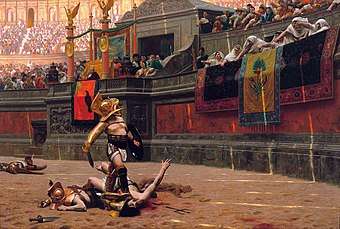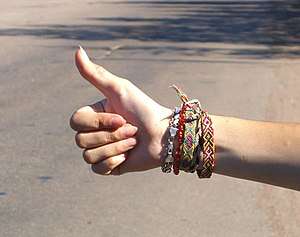Thumb signal
A thumb signal, usually described as a thumbs-up or thumbs-down, is a common hand gesture achieved by a closed fist held with the thumb extended upward or downward in approval or disapproval, respectively. These gestures have become metaphors in English: "The audience gave the movie the thumbs-up" means that the audience approved of the movie, regardless of whether the gesture was actually made.
History
Natural human behaviour
While the exact source of the thumb gesture is obscure, a number of origins have been proposed. Carleton S. Coon, having observed Barbary apes in Gibraltar using the gesture, hypothesised in the anthropological classic The Story of Man that it is a mutual celebration of having opposable thumbs.[1] Critics have suggested, however, that the apes may be simply imitating humans.
Ancient Rome

The Latin phrase pollice verso is used in the context of gladiatorial combat for a hand gesture used by Ancient Roman crowds to pass judgment on a defeated gladiator.
Now they give shows of their own. Thumbs up! Thumbs down! And the killers, spare or slay, and then go back to concessions for private privies.
— Juvenal, Against the City of Rome (c. 110–127 A.D.)
While it is clear that the thumb was involved, the precise type of gesture described by the phrase pollice verso and its meaning are unclear in the historical and literary record.[2][3][4] According to Anthony Corbeill, a classical studies professor who extensively researched the practice, thumbs up signalled killing the gladiator while "a closed fist with a wraparound thumb" meant sparing him.[5][6] In modern popular culture, necessarily without a historical basis from Ancient Rome, it is presumed that "thumbs down" was the signal that a defeated gladiator should be condemned to death; "thumbs up", that he should be spared.
Middle Ages
It has been suggested that 'thumbs up' was a signal from English archers preparing for battle that all is well with their bow and they are ready to fight. Before use, the fistmele (or the "brace height") was checked, that being the distance between the string and the bow on an English longbow. This fistmele should be about 7 inches (18 cm), which is about the same as a fist with thumb extended. The term fistmele is a Saxon word that refers to that measurement.[7]
Desmond Morris in Gestures: Their Origins and Distribution traces the practice back to a medieval custom used to seal business transactions. Over time, the mere sight of an upraised thumb came to symbolize harmony and kind feelings. For an example in the seventeenth century see the Diego Velázquez painting The Lunch.
20th century

The Oxford English Dictionary cites the earliest written instance of "thumbs-up" (with a positive meaning) as being from Over the Top, a 1917 book written by Arthur Guy Empey. Empey was an American who served in the British armed forces during World War I. He wrote: "Thumbs up, Tommy’s expression which means ‘everything is fine with me'." A visual example of the British use of "thumbs up" having a positive meaning (or, "okay") from the 1920s can be seen 19 minutes into the British-made silent 1927 film The Lodger: A Story of the London Fog, where the younger man examines some paper money for the older man and declares it "good" (not counterfeit) with a "thumbs up" using both hands.[8]
Popularization in the United States is generally attributed to the practices of World War II pilots, who used the thumbs up to communicate with ground crews prior to take-off. This custom may have originated with the China-based Flying Tigers, who were among the first American flyers involved in World War II. The appreciative Chinese would say ting hao de (挺好的) meaning "very good", and gesture with a thumbs up, which in Chinese means "you're number one". High officials in the Chinese government see it as a sign of respect. Any person from China will recognize this numerical gesture, and it can be seen in movies and photos of the era, though this has not been verified in print by American Volunteer Group (AVG) pilots.
During World War II, pilots on US aircraft carriers adopted the thumbs up gesture to alert the deck crew that they were ready to go and that the wheel chocks could be removed. On modern US carriers, certain deck crew hold a thumb up to signal to the pilot and control tower that their station is OK for take-off. American GIs are reputed to have picked up on the thumb gesture and spread it throughout Europe as they marched toward Berlin.[5] According to Luís da Câmara Cascudo, Brazilians adopted the thumbs up from watching American pilots based in northern Brazil during World War II.[9]
Senator John McCain of Arizona, when he cast the deciding vote that derailed a Republican repeal of the Affordable Care Act ("Obamacare") on July 28, 2017, used the thumbs down gesture.[10]
International usage


The thumbs up signal has a generally positive connotation in English-speaking countries. However, its perceived meaning varies significantly from culture to culture.[11]
The sign is said to have a pejorative meaning in countries including Iraq[5] and Iran.
In Germany, France, and Hungary, the gesture can simply indicate the number one, in the right context.
The thumbs up gesture is used on the logo of Thums Up, a popular brand of cola from India. Starting in 2007, the thumbs-up also appeared on India's one-rupee coin.[12]
In the United States, American Sign Language users use a single thumb up tilted slightly and rapidly left and right to indicate the number ten (10).[13] When held stationary and thrust toward another person the meaning is "yourself".[14] When lifted up by the other palm, the meaning is "help".[15] The handshape is employed in the production of numerous signs in American Sign Language beyond those mentioned here.
On the Internet, and most particularly on the social media site Facebook, the thumbs up gesture is shown as an icon and is associated with the term "like"—which within that context means to follow or subscribe to the page, posts, or profile of another individual or company; and on YouTube, individual videos may be voted on positively or negatively by clicking the thumbs-up or thumbs-down icons respectively (which in some previous versions of the site, used to be accompanied by "Like" and "Dislike" labels, and are still referred as such nowadays), and in the case of a thumbs-up, the video gets added to the user's "Liked videos" playlist. See Like button.
Context-specific usage


More recently, these gestures are associated with movie reviews, having been popularized by critics Gene Siskel and Roger Ebert[16] on their televised review show Siskel & Ebert—the thumb up meaning a positive opinion of a film; the thumb down meaning a negative one. The trademarked phrase "two thumbs up", originally meaning a positive review from both reviewers, has come to be used as an indication of very high quality or unanimity of praise.

By extension from the movie review usage,[17] many websites (including Facebook) allow users to approve or disapprove of items, such as comments in a forum, products in a store, or even other people's reviews of movies, books, products, etc., by choosing to click either a thumbs-up or thumbs-down button. In the aggregate, this serves as an evaluation system. Other users may then see the total number of thumbs up and thumbs down given to an item, or may simply see the number which is produced by subtracting thumbs down from thumbs up. (In the latter case, an item which has received exactly ten of each would read as having a rating of zero, rather than one of +10/-10.) Often, users may view a list of items in order of popularity, as ranked by this metric.
Hitchhikers in the West traditionally use a thumb gesture to solicit rides from oncoming vehicles, although in this presentation the arm is generally outstretched with the palm and closed fingers facing the motorist. The gesture is usually performed with the hand nearest the motorist and points down the road, indicating the hopeful destination. A hitchhiker may wave the hand, emphasizing the directional meaning. This is similar to the "thumb towards the door" gesture, for "get out of here!"[18]
In scuba diving, the thumbs-up gesture is a specific diving signal given underwater, in which the diver indicates that he or she is about to stop his or her dive and ascend. This occasionally causes confusion in new divers, who might automatically gesture thumbs-up when trying to indicate approval—actually indicating a desire to stop diving and to ascend. The diving signal for approval is the A-ok sign.[19]
In basketball, when a held ball occurs, an official will jerk both thumbs in the air, signalling that a jump ball is in order.
In baseball, umpires will sometimes jerk a thumbs-up over their shoulder as an "out" signal
Amusement park rides such as roller coasters are usually cleared for departure using a thumbs-up signal from the crew after inspection that all safety precautions have been taken.
The Indian cola brand Thums Up, now owned by The Coca-Cola Company, is named after this symbol and uses it as its logo.
Texas A&M University uses a thumbs-up as their Gig 'em hand signal, as it represents the action of gigging. The gesture and corresponding slogan "Gig 'em, Aggies!" were popularized in the early 20th century, becoming the first hand sign of the Southwest Conference.[20]
Unicode
Unicode code points related to thumb signals include:
- U+1F44D 👍 THUMBS UP SIGN
- U+1F44E 👎 THUMBS DOWN SIGN
- U+1F592 🖒 REVERSED THUMBS UP SIGN
Other encodings
Many keyboard emoticons utilize the shapes of lowercase "b" and "d" to represent a thumbs-up sign. Simple versions incorporate a dash for the wrist: -b (right hand) and d- (left hand). Many Japanese kaomoji icons place the thumbs beside a face constructed from punctuation marks, such as d(^^)b or b(~_^)d.[21] Various instant messaging services use (y) and (n) as a shortcut for thumbs up and thumbs down emoji.[22][23]
See also
| Wikimedia Commons has media related to Thumb gestures. |
- Gesture
- OK (gesture)
- Finger (gesture)
- Gig 'em
References
- Carlton S. Coon: "The Story of Man" (1954)
- "James Grout: The Gladiator and the Thumb, part of the Encyclopædia Romana". Penelope.uchicago.edu. Retrieved 2013-07-03.
- "Desmond Morris, Peter Collett, Peter Marsh and Marie O'Shaughnessy, 1979 Webified by Bernd Wechner: Gestures: Their Origin and Meanings, The Thumb Up". Bernd.wechner.info. Retrieved 2013-07-03.
- "Did The Romans Turn Thumbs Down On Gladiators?". News.ku.edu. 1997-09-29. Retrieved 2013-07-03.
- Koerner, Brendan (28 March 2003). "What does a "thumbs up" mean in Iraq?". Slate Magazine. Retrieved 4 January 2020.
- Where Does the 'Thumbs-Up' Gesture Really Come From?, Time
- Hagar, George (1841). "Chapter 10". Of the Shaft, Ancient and Modern. The Archery Library: Hansard.
- "The Lodger: A Story of the London Fog". YouTube. Retrieved 2018-08-11.
- Toledo, Roberto Pompeu de (March 14, 2007). "Uma paixão dos brasileiros". Veja Magazine (1999): 110.
- Peter W. Stevenson. "The iconic thumbs-down vote that summed up John McCain's career". washingtonpost.com.
- Strazny, Philipp (2005). Encyclopedia of Linguistics: M-Z. Fitzroy Dearborn. p. 812. ISBN 1-57958-451-9.
- "এক টাকার কয়েন তৈরি করতে কত খরচ ? যা জানা গেল– News18 Bengali". bengali.news18.com (in Bengali). December 7, 2018. Retrieved 7 January 2019.
- "Ten". ASL Browser. Michigan State University Communication Technology Laboratory. Archived from the original on 2011-07-20.
- "Yourself". ASL Browser. Michigan State University Communication Technology Laboratory. Archived from the original on 2011-07-20.
- "Help". ASL Browser. Michigan State University Communication Technology Laboratory. Archived from the original on 2011-07-20.
- CBS (2 January 2011). "Roger Ebert's New Voice" – via YouTube.
- Pulver, Andrew (23 June 2016). "'Thumbs down': female critics vastly outnumbered by male counterparts – new study". The Guardian. London. Retrieved 2 May 2017.
- Wickman, Forrest. "Digit to Ride". Slate. Retrieved 2 May 2017.
- Feather, Lauren. "Hand signals are the most effective means of communication underwater. Do you know which are the most common?". scubadiverlife.com. Retrieved 2 May 2017.
- Burka, Paul, "Football Hand Signals", Texas Monthly, archived from the original on December 22, 2004, retrieved 2007-07-10
- "thumbs up | Japanese Emoticons | Jemoticons (´・ω・`)". www.jemoticons.com. Retrieved 16 January 2019.
- "List of emoticons in MSN messenger".
- "Thumb Up / Like Sign Facebook Chat Emoticons Shortcut Keys Code Dislike button". November 3, 2011.